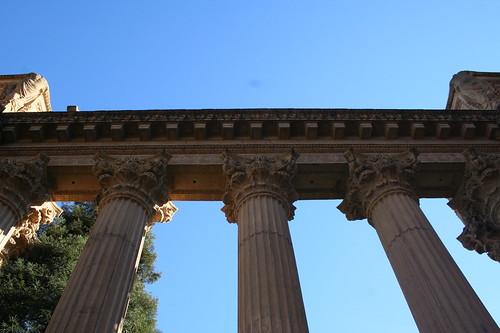
Etymology
The word Marble is derived from the Greek word Marmaros which means "shining stone" This is probably a reference to the translucent property of pure white marble which seams to make it glow when light is shone upon it.
Formation
Marble is a type of metamorphic rock.
Marble starts off as either a Limestone or Dolostone, with a lot of the mineral Calcite in it. When this is exposed to the right amount of heat and pressure, the material changes into marble.
This heat or pressure causes a process known as recrystallization. That is where the tiny individual grains that make up the original stone are changed, in this case into larger grains.
The result is that the original stone is transformed, into marble.
Art
Marble has a long tradition of being used in sculpture. This is because of several reasons.
Marble is a relatively soft natural stone, making it easy to carve.
Marble formed from pure calcite can sometimes be translucent, and light can penetrate the stone slightly. This makes sculptures seam to glow when illumination is shone on them.
Unlike some stones, whose minerals form in layers, marble's inherent grains don't tend to arrange themselves in straight lines. When a stone which is formed in layers is chiseled, large chunks tend to break off at random, making it difficult to control what the final statue will look like. The individual grains in marble however do not form in lines and therefore you can chisel off as much or as little as you like.
Architecture
Marble is a very popular building material used in architecture and design.
Marble can be obtained in almost any shape, giant blocks, slabs, or raw chunks.
The most popular shape for marble is in tile form.
Tiles can range from 4" - 24" square, although larger tiles tend to be less stable and more apt to crack.
Other Uses
Ground up into a fine powder, marble is a component material used in some glues and mortars, as well as toothpaste and various plastics
Meaning
Marble tends to be considered an elegant material. It is also tied closely to the classical Greek and Roman periods. A relatively expensive, and difficult to maintain stone, it is most often used in delicate and upscale applications
Care and Maintenance
Marble has tiny pores in its surface, which are too small to see with the bear eye, but which are large enough to soak up moisture. Sometimes liquid, especially colorful liquids such as fruit juices can soak into the pores in the marble, permanently discoloring it.
To prevent this a below surface sealer can be applied which will clog the pores making it impossible for moisture to penetrate it.
A chemical barrier can also be applied to marble which will form an invisible layer over its surface, protecting it further.
Joey Lewitin is the internet's premiere expert on natural stone and its decorative uses. To see his line of imported marble vases and decorative decor you can visit http://PebbleZ.com